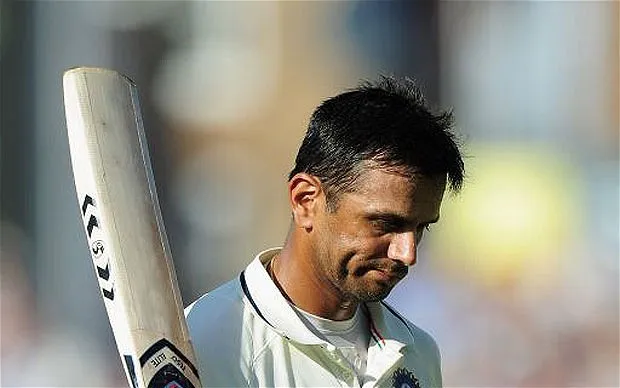Rahul Dravid is his role model, and social impact is his passion
How coming from a working-class background helped shape this entrepreneur’s goal to set up a firm that helps funders get the optimal social return on their investment.
Most people believe that when you are in your teens and don’t have faith that good will prevail in the end, or that every problem has a solution, then there is something odd. And after 35, if you still believe that good prevails in the end or that every problem has a solution then too there is something odd.

But most people are wrong. A continued faith that every problem is solvable is the key to making this world a better place. Here is the story of a 38-year-old social entrepreneur who I caught up with in my pursuit of putting together a book on India’s search for solutions for its seemingly unsolvable problems.
I met up with Rathish at a coffee shop in Koramangala on a lazy Saturday, December morning. The two hours were well spent and insightful. The myth that social entrepreneurs are different was once again busted. He comes across as any smart consultant from McKinsey in terms of articulation and thought process.
Childhood
The experience of growing up in a working-class neighbourhood defines who Rathish is today. His dad did two shifts on the factory-floor to run the family and his mother taught herself vocational skills so that she could earn for the family and support their needs.
Apart from this, his dad used to bring cycle spare parts home so that they could assemble them after 6 PM and sell them by weight at the small-scale factory a few kilometres away. He has been on loans and scholarships since the age of 10, right until the time he finished his education. He studied at BITS Pilani, interned at INSEAD and spent three years working in France and Germany.
This background helps him stay grounded and reminds him that there is nothing romantic about poverty.
He learned the value of hard work and commitment sitting on a bench on ‘Philosopher’s Walk’ in Heidelberg, Germany, and reading the book Zen and the Art of Motorcycle Maintenance – a moment that has defined his approach to work since.
At the core
Rathish is an engineer and finding elegant solutions to complex problems gives him the greatest satisfaction. What has evolved is the nature of the problems and the definition of elegance. Today, the problems that give him most satisfaction are of two types:
- Creating simple, scalable and sustainable solutions for social organisations to achieve orbit-shifting growth. And for that to happen, the solution needs to be disruptive in scope and scale but organic to the organisation’s values and philosophy. Finding that right balance is critical and extremely satisfying.
- Demonstrating models on the ground that can scale.
His dream/vision
To end poverty – in whatever definition one chooses to give it – in his lifetime.
Hi role model – Rahul Dravid

Rathish explains that like many other cricketers, Rahul Dravid too was supremely talented, but he evolved so much through his playing career. No one would have imagined Dravid hitting 50 off 33 balls in his career or being a wicket-keeper. But he did all that and more – and did that by being grounded and by being the nicest guy to have played on the field. And for him, that was a huge lesson – leveraging his strengths, constantly challenging himself, working on a larger goal, and doing all this by staying grounded and humble.
His current focus is helping funders improve the social return on their investment and creating value positions that the market is willing to pay for.
Rathish recalls an article by Silicon Valley author and entrepreneur Guy Kawasaki, which said something to the effect of, “While your vision and mission statements can inspire the world, how you make money has to be as straightforward as possible.” He goes on to say that this is especially important for organisations working on social impact, because it is very easy to mix the world-changing and inspiring vision with the value proposition that the market is willing to pay for.
I haven’t seen a lot of the profit-driven entrepreneurs think with this level of clarity.
In other words, funders, including philanthropic organisations, corporations, and investors, are investing to further social impact. However, there is a gap between the intended impact they would like to achieve to the actual impact on the ground. Rathish’s organisation, Sattva, helps address this gap by improving the impact for every rupee invested by the funders. These funders, in his experience, are broadly of three categories:
- Those who are looking to create innovative solutions to large-scale problems, pilot them on the ground and demonstrate potential to scale.
- Those investing in innovative organisations that have the potential to create scalable solutions to large-scale problems.
- Those investing in replicating proven solutions in their circle of concern (such as their local communities), and in the process strengthening the execution capacity of the organisation.
How is he doing it?

By focusing on three specific aspects, all of which fundamentally define the people Sattva hires, and the culture his team is building at Sattva.
- Strong implementation focus
By consciously being an organization that is able to play a hands-on role on the ground and bring those insights back to the strategy table. He clarifies to every candidate he interviews for Sattva that it is quite unlikely that anyone from Sattva is ever going to transition to a pure-play strategy consulting firm after this. But they can surely be effective COOs for any social organisation that wants to manage complex operations on the ground.
- Cross-sector and ross-stakeholder approach
The solutions to the complex problems that funders are keen on solving today are inherently cross-sector and cross-stakeholder and require multiple entities to work together across focus areas. Hence there is a need for an orchestrator who has the ability and the mindset to bring these stakeholders together and ensure that the overall solution works well. The singular challenge that Rathish and Sattva face in effecting such solutions on the ground is the lack of trust among the stakeholders. Hence, one of the most important qualities that they seek in people they hire is empathy.
- Strong focus on outcomes
Today, funders increasingly bring greater understanding of the nuances of sector and are able to identify the blind spots easily. Sattva’s ability to take that insight several notches deeper, to engage on the ground and action those insights to outcomes is today our strongest differentiator.
As an insider-outsider on the ground, Sattva is able to not only able to align stakeholders on the key measurable outcomes but also bring the relevant process rigor and outcome focus during the execution. And within the organisation, it is an ongoing effort to instill that focus in every employee to keep the outcome in mind at all times. As we continue to grow, this will become one of the most important aspects we institutionalise as part of our culture.
Rathish believes that working with different stakeholders, working with a strong market and outcome focus, an ability to operate at the intersection of business and impact are more relevant today than ever before.
At the end of the conversation, he is excited to contribute to the book and I have met my goal.
(Disclaimer: The views and opinions expressed in this article are those of the author and do not necessarily reflect the views of YourStory.)







